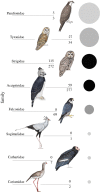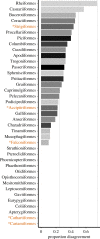Towards reconciliation of the four world bird lists: hotspots of disagreement in taxonomy of raptors
- PMID: 32546096
- PMCID: PMC7329027
- DOI: 10.1098/rspb.2020.0683
Towards reconciliation of the four world bird lists: hotspots of disagreement in taxonomy of raptors
Abstract
There are currently four world bird lists referenced by different stakeholders including governments, academic journals, museums and citizen scientists. Consolidation of these lists is a conservation and research priority. In reconciling lists, care must be taken to ensure agreement in taxonomic concepts-the actual groups of individual organisms circumscribed by a given scientific epithet. Here, we compare species-level taxonomic concepts for raptors across the four lists, highlighting areas of disagreement. Of the 665 species-level raptor taxa observed at least once among the four lists, only 453 (68%) were consistent across all four lists. The Howard and Moore Checklist of the Birds of the World contains the fewest raptor species (528), whereas the International Ornithological Community World Bird List contains the most (580) and these two lists are in the most disagreement. Of the disagreements, 67% involved owls, and Indonesia was the country containing the most disagreed upon species (169). Finally, we calculated the amount of species-level agreement across lists for each avian order and found raptor orders spread throughout the rankings of agreement. Our results emphasize the need to reconcile the four world bird lists for all avian orders, highlight broad disagreements across lists and identify hotspots of disagreement for raptors, in particular.
Keywords: bird of prey; checklist; raptor; taxonomic concept; taxonomy; world bird list.
Conflict of interest statement
We declare we have no competing interests.
Figures





References
-
- Faurby S, Eiserhardt WL, Svenning JC. 2016. Strong effects of variation in taxonomic opinion on diversification analyses. Methods Ecol. Evol. 7, 4–13. (10.1111/2041-210X.12449) - DOI
Publication types
MeSH terms
Associated data
LinkOut - more resources
Full Text Sources

